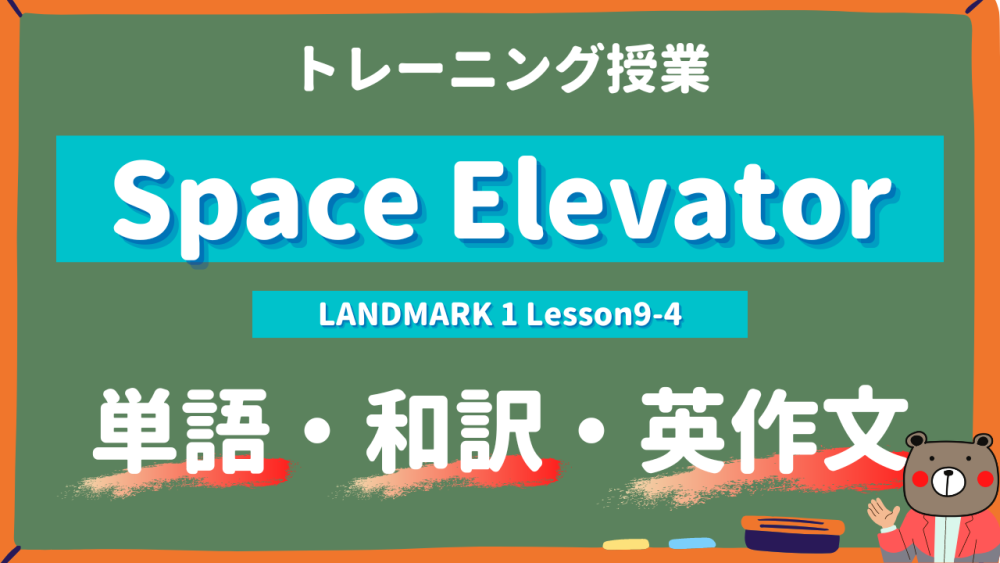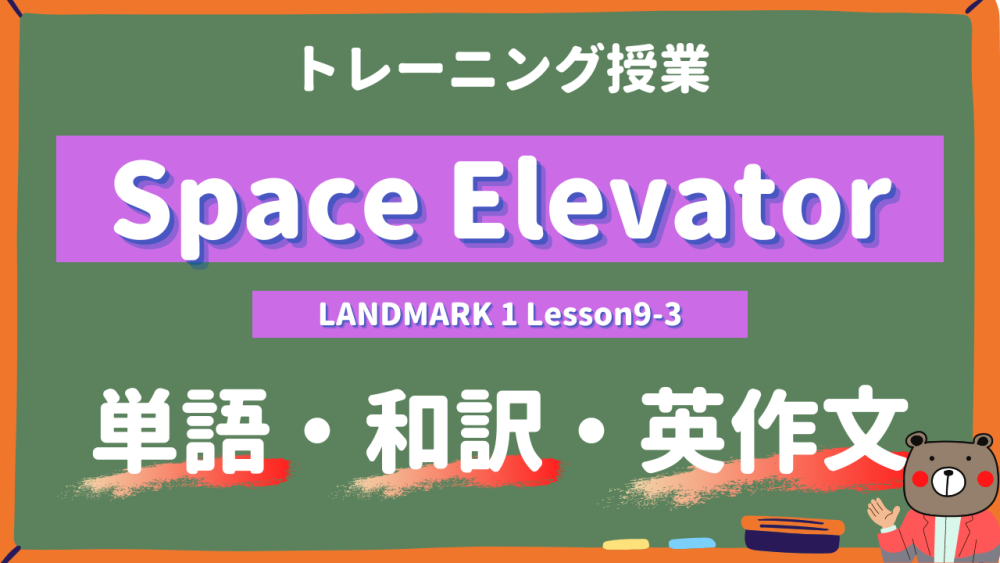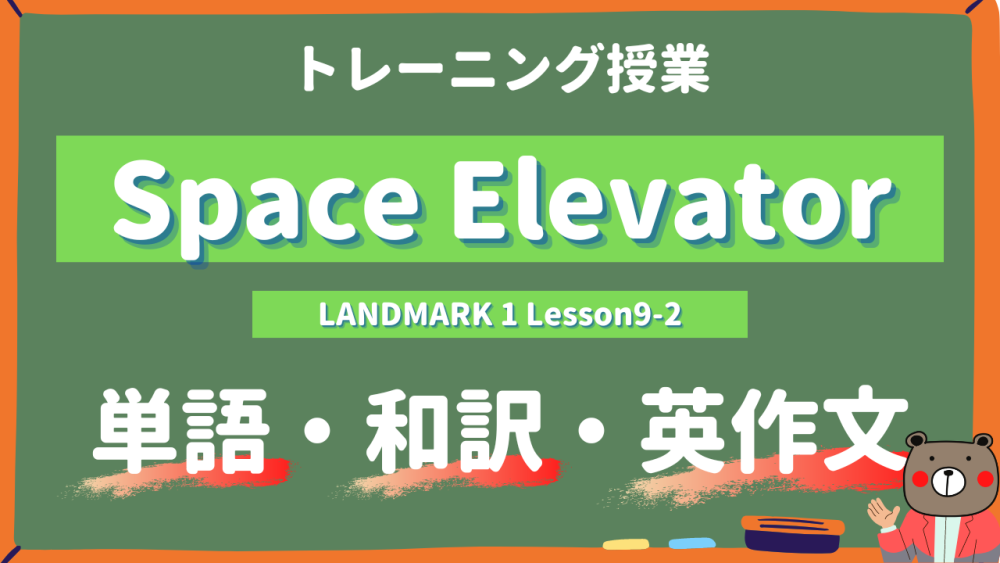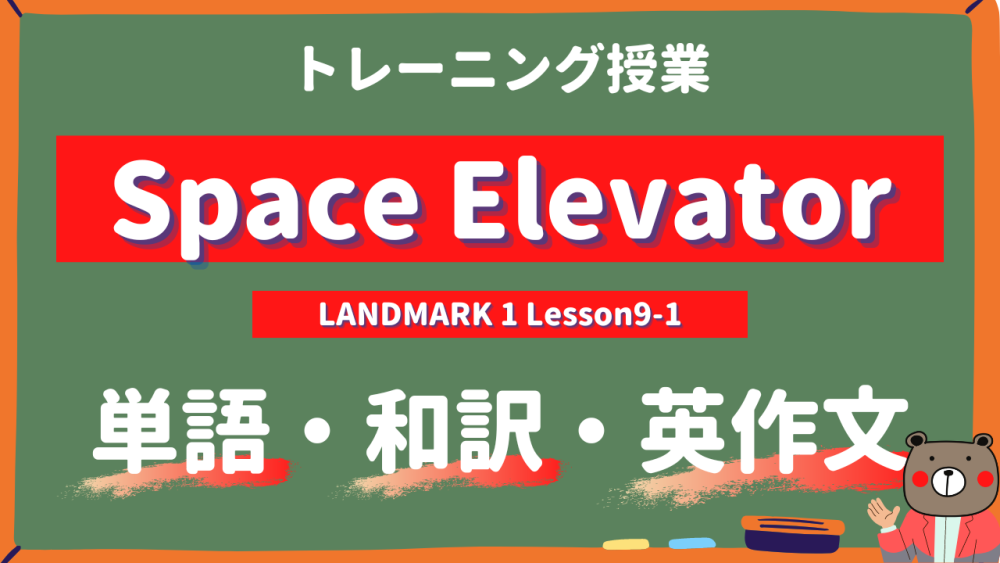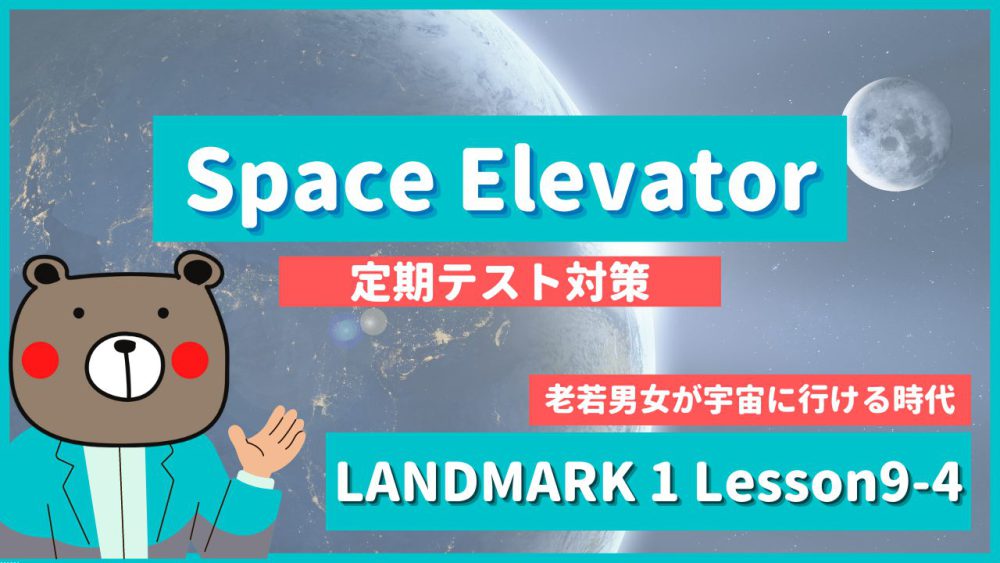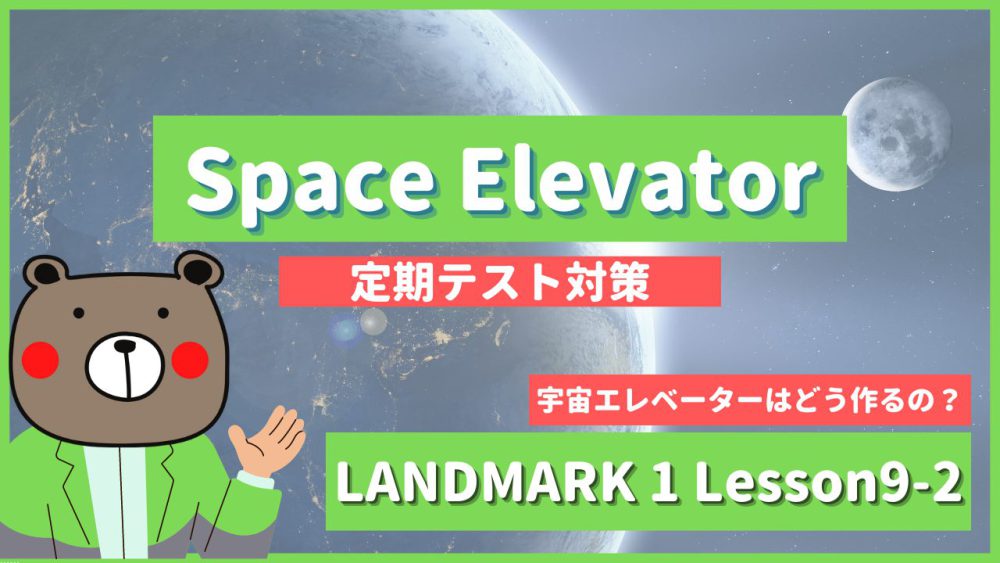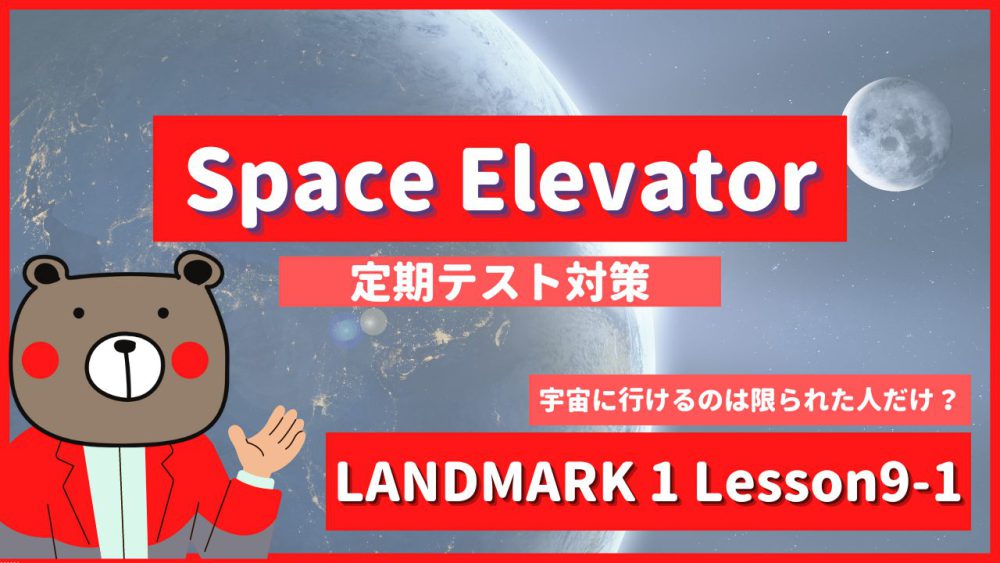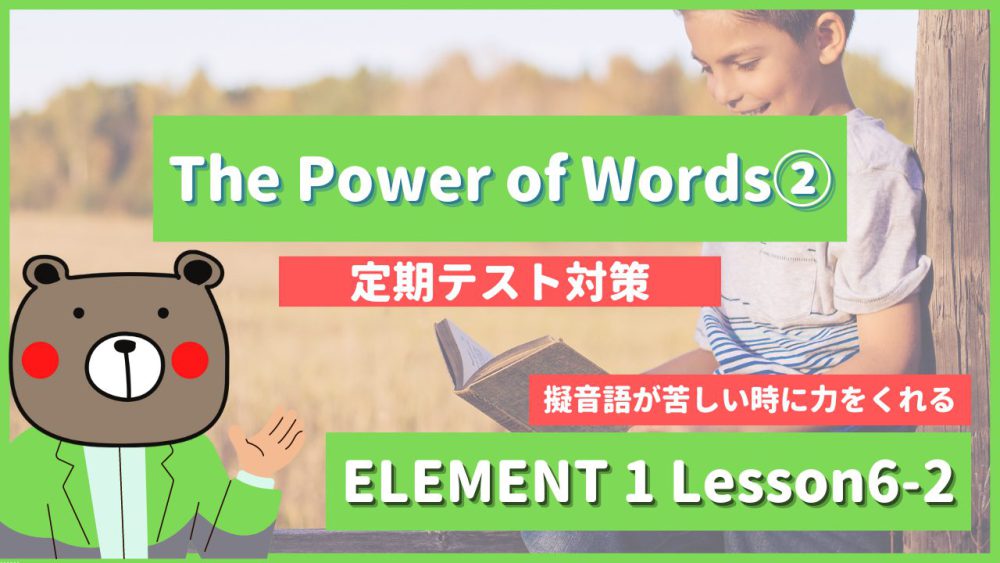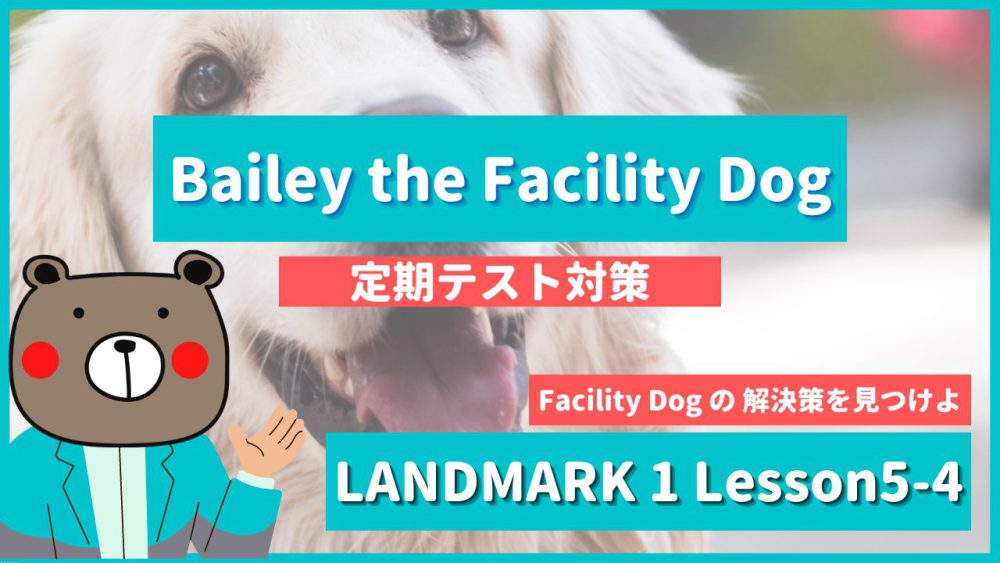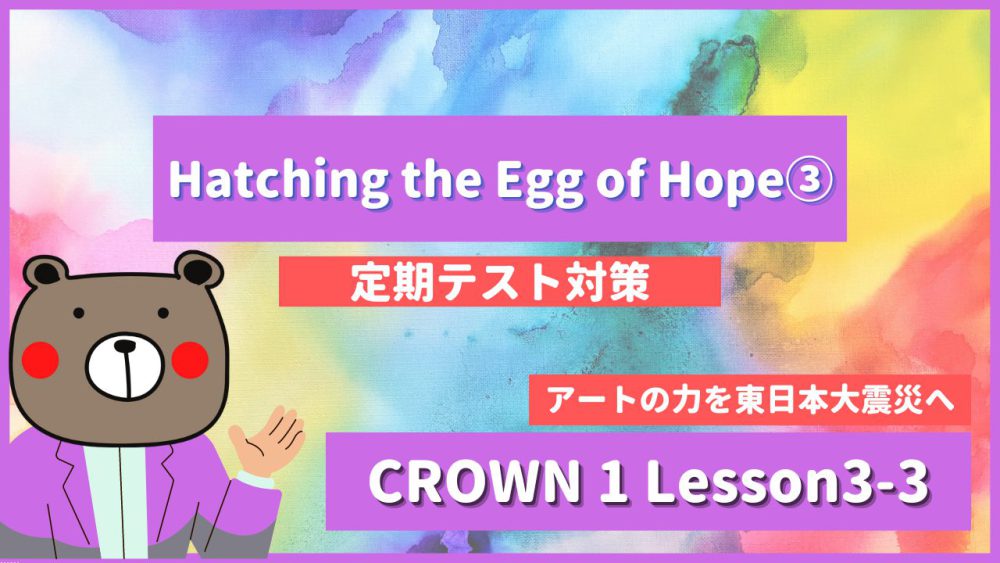▼音声で学びたい方はこちらへ🐻
現在撮影中❗️

▼LANDMARK1-高1《Lesson9》はこちらから🐻
- 授業前にひとこと
- 勉強のポイント
- 本文&和訳
- 重要単語
- 重要ポイント
- 【1】What kind of cable does the space elevator need?
- 【2】What did Dr. Iijima discover in 1991?
- 【3】The space elevator needs an extremely long cable.
- 【4】It must be about 100,000km long.
- 【5】That is about eight times longer than the Earth’s diameter!
- 【6】Such a long cable might be broken by the pull of the Earth’s gravity and the centrifugal force.
- 【7】Therefore, the cable must be more than about 100 times as strong as steel.
- 【8】Until the 1990s, no one knew what kind of material would be strong enough for this cable.
- 【9】This was the biggest problem in the development of the space elevator.
- 【10】In 1991, Dr. Iijima Sumio, a Japanese scientist, discovered a potential material for the space elevator cable.
- 【11】It is called “carbon nanotubes.”
- 【12】If this material did not exist, the space elevator would remain only in science fiction.
- 【13】Carbon nanotubes are made of carbon and are the lightest and strongest material on Earth.
- 【14】They are about 50,000 times as thin as a human hair and about 20 times as strong as steel.
- 【15】Researchers are now working hard to produce a long and tough carbon nanotube cable.
授業前にひとこと


今回も、LANDMARK1-高1《Lesson9》について扱っていきます❗️
Lesson9のタイトルは…🐻
Space Elevator
という「宇宙へ行く最新技術」についてのお話です。
ちなみに、このLessonでは…
冒頭の Question を踏まえて文章を読む
のを意識してください❗️
さて、いつも授業前に説明することですが…
⇧に載せてあります『単語・和訳・英作文トレーニング』をテスト1週間前から毎日やってみてください❗️曖昧な理解がなくなり、成績が爆伸びします!!
コミュ英以外の定期テスト対策は?
現代文の定期テスト対策は こちら から
古文の定期テスト対策は こちら から
漢文の定期テスト対策は こちら から
teite channel をもっと活用する


▷ 解説記事のリクエスト
▷ 新着情報のキャッチ
▷ 定期テスト予想問題
▷ オリジナルグッズの購入
ができるようになっています🐻
teite channel の 公式LINEアカウント はこちら
勉強のポイント
①本文は、宇宙エレベーターを支える可能性を秘めた素材『カーボンナノチューブ』を説明していることを理解する。
②単語・重要ポイントをインプットする。
③冒頭の Question を踏まえて文章を読む。
本文&和訳
Question5
What kind of cable does the space elevator need?
どんな種類のケーブルを宇宙エレベーターは必要としていますか?
Question6
What did Dr. Iijima discover in 1991?
飯島博士は1991年に何を発見しましたか?
本文(Part3)
【5】The space elevator needs an extremely long cable.
宇宙エレベーターはとてつもなく長いケーブルを必要とします。
It must be about 100,000km long.
それはきっと約100,000kmの長さになるでしょう。
That is about eight times longer than the Earth’s diameter!
それは地球の直径より約8倍長いです。
Such a long cable might be broken by the pull of the Earth’s gravity and the centrifugal force.
このように長いケーブルは地球の重力の引っ張りと遠心力によって、壊れるかもしれません。
Therefore, the cable must be more than about 100 times as strong as steel.
ゆえに、ケーブルは鉄の約100倍以上の強度がなければなりません。
Until the 1990s, no one knew what kind of material would be strong enough for this cable.
1990年代まで、どんな種類の素材がこのケーブルに対する十分な強度を持つのか、誰も知りませんでした。
This was the biggest problem in the development of the space elevator.
これが宇宙エレベーターの発展における最も大きな問題でした。
【6】In 1991, Dr. Iijima Sumio, a Japanese scientist, discovered a potential material for the space elevator cable.
1991年、日本の科学者である飯島澄男博士は宇宙エレベーターに対する可能性を秘めた素材を発見しました。
It is called “carbon nanotubes.”
それは「カーボンナノチューブ」と呼ばれています。
If this material did not exist, the space elevator would remain only in science fiction.
もしこの素材が存在していないなら、宇宙エレベーターはSF小説の中だけのままでしょう。
Carbon nanotubes are made of carbon and are the lightest and strongest material on Earth.
カーボンナノチューブは炭素から作られていて、地球上で最も軽く、最も強い素材です。
They are about 50,000 times as thin as a human hair and about 20 times as strong as steel.
それらは人間の髪より約50,000倍細く、鉄より約20倍強いです。
Researchers are now working hard to produce a long and tough carbon nanotube cable.
研究者は、長くて頑丈なカーボンナノチューブのケーブルを産み出すために、今も一生懸命働いています。
重要単語


V : 動詞 , Ving : 動名詞 , Vpp : 過去分詞, O:目的語, C:補語
| extremely | 極度に、きわめて |
| steel | 鉄 |
| material | 素材 |
| development | 発展、開発 |
| carbon | 炭素 |
| nanotube | ナノチューブ |
| remain | 〜のままである |
| researcher | 研究者 |
| tough | 頑丈な |
| be made of A | Aから作られている |
重要ポイント
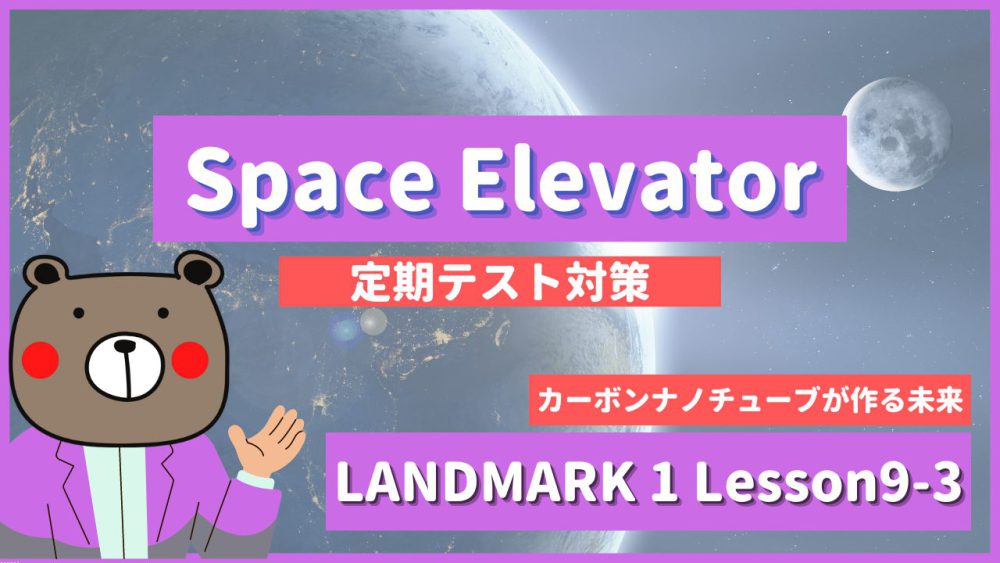

「ピンク」=重要ポイント
▼記号について
V : 動詞 Ving : 動名詞 Vpp : 過去分詞
【 】名詞句・節 〈 〉形容詞句・節 ( )副詞句・節
S:主語 O:目的語 C:補語 M:副詞
【1】What kind of cable does the space elevator need?
《和訳》
どんな種類のケーブルを宇宙エレベーターは必要としていますか?
《重要ポイント》
ここまで執筆完了❗️日々解説を加えていきます!


teite channel の 公式LINEアカウント はこちら
【2】What did Dr. Iijima discover in 1991?
《和訳》
飯島博士は1991年に何を発見しましたか?
《重要ポイント》
【3】The space elevator needs an extremely long cable.
《和訳》
宇宙エレベーターはとてつもなく長いケーブルを必要とします。
《重要ポイント》
【4】It must be about 100,000km long.
《和訳》
それはきっと約100,000kmの長さになるでしょう。
《重要ポイント》
【5】That is about eight times longer than the Earth’s diameter!
《和訳》
それは地球の直径より約8倍長いです。
《重要ポイント》
【6】Such a long cable might be broken by the pull of the Earth’s gravity and the centrifugal force.
《和訳》
このように長いケーブルは地球の重力の引っ張りと遠心力によって、壊れるかもしれません。
《重要ポイント》
【7】Therefore, the cable must be more than about 100 times as strong as steel.
《和訳》
ゆえに、ケーブルは鉄の約100倍以上の強度がなければなりません。
《重要ポイント》
【8】Until the 1990s, no one knew what kind of material would be strong enough for this cable.
《和訳》
1990年代まで、どんな種類の素材がこのケーブルに対する十分な強度を持つのか、誰も知りませんでした。
《重要ポイント》
【9】This was the biggest problem in the development of the space elevator.
《和訳》
これが宇宙エレベーターの発展における最も大きな問題でした。
《重要ポイント》
【10】In 1991, Dr. Iijima Sumio, a Japanese scientist, discovered a potential material for the space elevator cable.
《和訳》
1991年、日本の科学者である飯島澄男博士は宇宙エレベーターに対する可能性を秘めた素材を発見しました。
《重要ポイント》
【11】It is called “carbon nanotubes.”
《和訳》
それは「カーボンナノチューブ」と呼ばれています。
《重要ポイント》
【12】If this material did not exist, the space elevator would remain only in science fiction.
《和訳》
もしこの素材が存在していないなら、宇宙エレベーターはSF小説の中だけのままでしょう。
《重要ポイント》
【13】Carbon nanotubes are made of carbon and are the lightest and strongest material on Earth.
《和訳》
カーボンナノチューブは炭素から作られていて、地球上で最も軽く、最も強い素材です。
《重要ポイント》
【14】They are about 50,000 times as thin as a human hair and about 20 times as strong as steel.
《和訳》
それらは人間の髪より約50,000倍細く、鉄より約20倍強いです。
《重要ポイント》
【15】Researchers are now working hard to produce a long and tough carbon nanotube cable.
《和訳》
研究者は、長くて頑丈なカーボンナノチューブのケーブルを産み出すために、今も一生懸命働いています。
《重要ポイント》


これで全て終了です❗️
「LANDMARK1-高1《Lesson9-3 | Space Elevator | p156~157》」おつかれさまでした🐻
Questionを踏まえて読解すれば、比較的話しの流れは掴みやすいですが、それが出来ていないと知らない熟語や構文が出てきたり、単語のレベル高かったりで、苦戦している人もいるのではないでしょうか❗️
復習&音読するのをお忘れなく!!
①授業前にひとこと、でも話しましたが…
⇧に載せてあります『単語・和訳・英作文トレーニング』をテスト1週間前から毎日やってみてください❗️曖昧な理解がなくなり、成績が爆伸びします!!
最後まで見てくださってありがとうございました!
またお会いしましょう!定期テストがんばれ〜🐻
じゃあね〜、バイバイ!!
